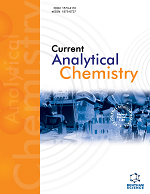- Home
- A-Z Publications
- Current Analytical Chemistry
- Previous Issues
- Volume 1, Issue 3, 2005
Current Analytical Chemistry - Volume 1, Issue 3, 2005
Volume 1, Issue 3, 2005
-
-
Mass Spectrometry for the Analysis of Highly Charged Sulfated Carbohydrates
More LessAuthors: Lianli Chi, Jonathan Amster and Robert J. LinhardtSulfated polysaccharides and their oligosaccharide components play an important biological role in physiological and pathophysiological processes. Glycosaminoglycans, such as heparin, are currently used as pharmaceutical agents to control coagulation. Moreover, there are intensive efforts in developing rapid approaches for the analysis of such bioactive carbohydrates to assess their pharmacological activity and in glycomic a Read More
-
-
-
Liquid Chromatography-Ion Trap-Mass Spectrometry and its Application to Determine Organic Contaminants in the Environment and Food
More LessAuthors: Vicente Andreu and Yolanda PicoRecent experiences with liquid chromatography-quadrupole ion trap-mass spectrometry (LC-QITMS), as an analytical tool for determining trace amounts of organic contaminants in food and environmental samples, are addressed in this review. A brief introduction to the fundamental theory for quadrupole ion trap devices illustrates possibilities and limitations of this technique. Special attention is paid to the impact of sample Read More
-
-
-
Identification of Degradation Products by Adopting GC or HPLC/MS Techniques
More LessAuthors: Paola Calza, Claudio Medana, Claudio Baiocchi and Ezio PelizzettiThe persistence of pesticides and drugs in products destined for human consumption is of great concern, in particular because of their potential carcinogenic character. However, often the transformation products formed through degradation processes possess higher toxicity than the parent compounds. It is then of primary importance not only to achieve their abatement (through purification procedures), but also to detect a Read More
-
-
-
New Applications, Processing Methods and Pulse Sequences Using Diffusion NMR
More LessAuthors: J. C. Cobas, P. Groves, M. Martin-Pastor and A. D. CapuaDiffusion NMR, and in particular the DOSY processing method (Diffusion Ordered SpectroscopY), is an attractive technique to characterize mixtures without first having to separate the components. As a result, DOSY can yield a vast amount of analytical information. General applications of DOSY are reviewed here although we emphasize specialist applications that provide unique data. Such applications include the analysis of kine Read More
-
-
-
Ligand Screening by Saturation-Transfer Difference (STD) NMR Spectroscopy
More LessNMR based methods to screen for high-affinity ligands have become an indispensable tool for designing rationalized drugs, as these offer a combination of good experimental design of the screening process and data interpretation methods, which together provide unprecedented information on the complex nature of protein-ligand interactions. These methods rely on measuring direct changes in the spectral para Read More
-
-
-
Flow Injection-Capillary Electrophoresis (FI-CE): Recent Advances and Applications
More LessAuthors: Grady Hanrahan, Froseen Dahdouh, Keith Clarke and Frank A. GomezThis paper presents a comprehensive review of how recent advances in flow injection-capillary electrophoresis (FI-CE) technology have led to enhanced separation capabilities of a wide range of analytes in such areas as biological, environmental, food, medical and pharmaceutical analysis. Significant developments in design, detection methodology and applications made in the last five years are reported. In addition, future Read More
-
-
-
Recent Advances in On-line Solvent Extraction Exploiting Flow Injection/Sequential Injection Analysis
More LessAuthors: Manuel Miro, Jose M. Estela and Victor CerdaIn this paper, the state-of-the-art of automated solvent extraction procedures exploiting flowing stream techniques is thoroughly presented and discussed. While flow-injection liquid-liquid extraction (FI-LLE) was originally associated with the use of a solvent extractor involving a segmentor and a phase separator, current analytical trends are focused on the design and characterisation of novel strategies for the removal of t Read More
-
-
-
Particle Separation in Microfluidic Devices — SPLITT Fractionation and Microfluidics
More LessAuthors: Yonghao Zhang, Robert W. Barber and David R. EmersonIn recent years, microfluidic devices have been increasingly used to separate particles such as colloids, macromolecules, cells, beads and droplets. Miniaturisation often introduces new functionalities and paradigms that are not possible at conventional macroscopic scales. In this paper, split-flow-thin fractionation techniques for particle separation are reviewed and the underlying physics of particle migration is discussed. The Read More
-
-
-
Protein Sequence and Structure Databases: A Review
More LessAuthors: Marcos J. Arauzo-Bravo and Shandar AhmadSeveral protein sequence and structure databases have emerged from a worldwide effort to curate the information on protein sequences and their structures. Sequences are written in different formats and certain standards have evolved. On the other hand, Protein Data Bank is the largest source of information on protein structures, and sets standards on the way structural information should be written. For handling large n Read More
-
-
-
The Role of Atomic Spectrometric Techniques in the Determination of Chemical Elements in Atmospheric Aerosols
More LessAuthors: Patricia Smichowski, Dario Gomez and Griselda PollaThis review covers the application of atomic and mass spectrometric techniques for the determination of metals and metalloids in atmospheric aerosols. Atomic spectrometric methods based on flame atomic absorption spectrometry (FAAS), electrothermal atomic absorption spectrometry (ETAAS), atomic fluorescence spectrometry (AFS), total reflection X-ray fluorescence (TXRF) spectrometry and plasma based techniques Read More
-
Volumes & issues
-
Volume 21 (2025)
-
Volume 20 (2024)
-
Volume 19 (2023)
-
Volume 18 (2022)
-
Volume 17 (2021)
-
Volume 16 (2020)
-
Volume 15 (2019)
-
Volume 14 (2018)
-
Volume 13 (2017)
-
Volume 12 (2016)
-
Volume 11 (2015)
-
Volume 10 (2014)
-
Volume 9 (2013)
-
Volume 8 (2012)
-
Volume 7 (2011)
-
Volume 6 (2010)
-
Volume 5 (2009)
-
Volume 4 (2008)
-
Volume 3 (2007)
-
Volume 2 (2006)
-
Volume 1 (2005)
Most Read This Month
Article
content/journals/cac
Journal
10
5
false
en


